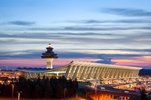This just isn't correct. First, you're focused very heavily on the later fairs. Yes, those are the ones Disney personally took part in, the ones with the most direct aesthetic impact on EPCOT, but they grew out of the much, much more culturally significant, earlier US fairs. Those are the fairs that laid the ideological and design foundation for what followed, including EPCOT. The Columbian Exposition in 1893 was the greatest of these and a pivotal moment in the formation of modern America, and shows the absolute centrality of corporations. The central court, the focus of everything at the fair, was surrounded by massive structures like the Electricity Building, Agriculture Building, Transportation Building, Machinery Building - this should all sound very familiar to anyone familiar with EPCOT, of course. The staggeringly huge buildings at the center of the fair featured some exhibits by foreign nations, but the dominant theme was human progress as a product of the American spirit channeled largely through corporations - "A tribute to all nations, but mostly America." The Transportation Building, for instance, centered on exhibits by various American railroad corporations, perhaps the most visible corporations of the era, with foreign (corporate) exhibits sprinkled throughout. It had exhibits by the B&O, Westinghouse, Pullman, and on and on. The foreign pavilions were much more peripheral (behind the Fisheries Building) and were themselves largely focused on corporate products. Other fairs of the era - Buffalo's Rainbow City, the St Louis Expo, etc - were very similar in their ideological and aesthetic design, which remained largely consistent through to EPCOT.


